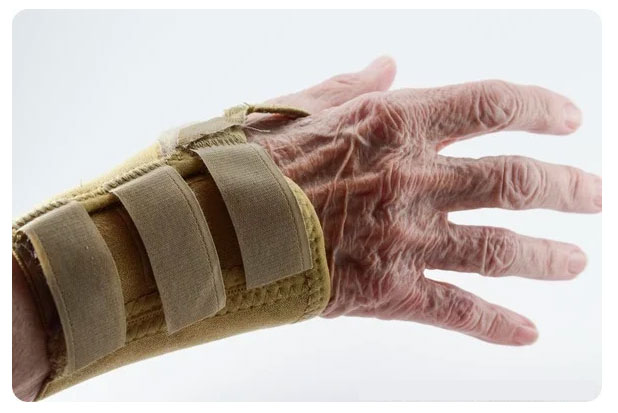As cold weather threatens most of the country, millions living with a chronic, autoimmune disorders such as rheumatoid arthritis (RA) may reach out to their healthcare provider about increased aches and pain or symptom flares.
The good news is that if patients and providers work together to develop a winter weather arthritis management plan, there’s a way to make these cold months much more comfortable.
Healthcare providers can proactively discuss helpful topics with their patients: safety precautions, essential winter gear, and physical activity in and out of inclement weather.
Can the weather predict joint pain?
The jury remains out about whether the decreasing barometric pressure or other weather changes are a primary reason for heightened joint pain. For example, one study completed at Tufts University in 2007 reported that an increase in joint paint was reported with every 10 degree drop in temperature, particularly when combined with low barometric pressure and precipitation.[i]
Several additional studies support this assessment, particularly in older patients.[ii],[iii],[iv],[v] Unfortunately, research has not confirmed the weather-pain pathway, so this phenomenon is still considered theoretical.[vi]
If it was clearly determined that a specific type of winter weather was associated with increased arthritis pain, then you might expect to see people living with chronic conditions migrate to warmer climates.
However, research shows that it’s not a specific climate that causes pain, but rather changes in the local climate. People become accustomed to their environment and will eventually become sensitive regardless of where they live, if they are susceptible to weather-related symptoms flare.[vii]
Another reason for an increase in pain and swelling during cold, wet weather is that cold air may cause an increase in the amount of muscle spasms and decrease blood circulation, aggravating the feeling of pain.[viii]
Therefore, while science doesn’t yet understand why some people may experience more pain when the weather changes, health care providers must help patients make lifestyle and/or medication adjustments according to their individual needs throughout the year.
Cold weather gear for arthritis patients
Applying heat to the joints that are covered by sparse soft tissue (e.g., hands and feet) can have substantial benefit to arthritis patients.[ix] However, self-treating joints and muscles with heat (or cold) needs to be done cautiously and with guidance from a physician.[x]
Getting dressed during periods of flare ups can be an exhausting struggle. During the cold winter months, having to dress in bulkier, water-resistant items can add to the stress. Arthritis patients may be better off dressing in layers which are easier to put on (and take off) and can provide just as much warmth as a single heavy sweater.
Additionally, when choosing outerwear, patients ought to think about both functionality (e.g., ease of opening and closing) and durability (weather protection). Despite keeping you warm and dry, bulky or heavy items can hinder ease of movement and even affect balance.
Besides layered clothing, another useful winter suggestion for arthritis patients is to wear warm compression gloves. According to a 2014 study[xi], hand symptoms such as pain, stiffness, and swelling improve substantially when therapy gloves are used, though improvement in hand function (with the exception of grip strength) is minimal.
Compression gloves vary in style and technology. Some have open fingers, others emit warmth via infrared heat. Note also that therapy gloves are generally meant to provide support rather than heat, which is useful all year long.

Winter weather exercise
Exercise is crucial for people living with arthritis, but the colder, wetter months and shorter days can make it harder to fit in a workout. Good advice for the whole year is to stay hydrated and get a five- minute warm up before engaging in any type of exercise to prevent muscle cramps.
In winter, if the sidewalks are clear of ice and the sun is out, people living with arthritis can be encouraged to walk outside to soak up some vitamin D. Vitamin D is important for RA patient as studies have shown that that lower vitamin D levels correlate with more severe clinical manifestations of RA and other rheumatic diseases.[xii] (Patients should still wear sunscreen to block harmful U.V. light.)
Low levels of vitamin D are also associated with sensitivity to pain and put someone at greater risk for osteoporosis.[xiii] If a patient is unable to go outside, vitamin D supplements and a healthy diet rich in vitamin D are suitable.
Unsafe environments
If ice has made the streets and sidewalks too risky, a gym membership might prove prudent, especially if the gym includes an indoor pool to permit a low impact exercise option. Before starting an exercise program, arthritis sufferers should spend some time with the fitness director to explain their goals and challenges and determine if there are any low impact group exercise classes available.
To get and remain motivated, arthritis patients might find an exercise buddy, possibly another person in their community who faces similar concerns about their health condition. This may facilitate a well-matched exercise partner and accountability for both. Generally, people are more inclined to try a new form of exercise, such as yoga or water aerobics, if they attend with a friend.
As with any exercise program, arthritis patients should consult with their healthcare provider for advice before beginning. Encourage them to start slow and let their body adjust to the change, increasing their workout time and intensity according to how their body feels and how well they adjust to the routine.
Winter weather chores
Work, chores, outside play, and errands do not stop when the weather turns cold. Driveways, stairs, and sidewalks need to be de-iced and shoveled, and early winter often includes a hectic holiday schedule.
De-icing and shoveling show
While taking children out to play and scattering salt to de-ice the driveway are smaller challenges, shoveling snow can be a daunting task. If paying someone to shovel is not an option, there are ways to ensure that this chore is tackled safely.
First, choose a sturdy, non-plastic shovel with a soft grip that is the correct length for their height. Staying ahead of the weather and shoveling in shifts can also help so that snow does not become too heavy or too slushy to lift. Push, don’t lift. To protect the back, patients should lift the shovel load with their legs and continue shoveling small amounts throughout the day so that the snow does not get too deep.[xiv],[xv]
Wood stacking, chopping, and carrying.
Another common winter weather chore is stacking and bringing in wood or kindling for the fire place. Fortunately, there are plenty of inexpensive items healthcare providers can recommend that are available for purchase to make this chore much easier.
There are a plethora of wood racks for proper stacking, light-weight fabric slings, and carriers for easier lifting, and even rolling log carts for hauling larger loads of wood indoors with ease. For smaller splitting jobs, there are splitters available designed for ease of use and reduction of back pain.
Use your resources. As with all exercise and activity, patients should check with their healthcare provider prior to starting. In return, healthcare providers should be prepared with modifications to suggest to their patients.
Arthritis patients can also seek information and support from CreakyJoints, the go-to source for more than 100,000 arthritis patients and their families world-wide who are seeking education, support, advocacy and patient-centered research. Often other people living with RA and other forms of arthritis are the best sources for innovative and original problem-solving.
